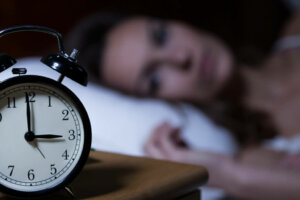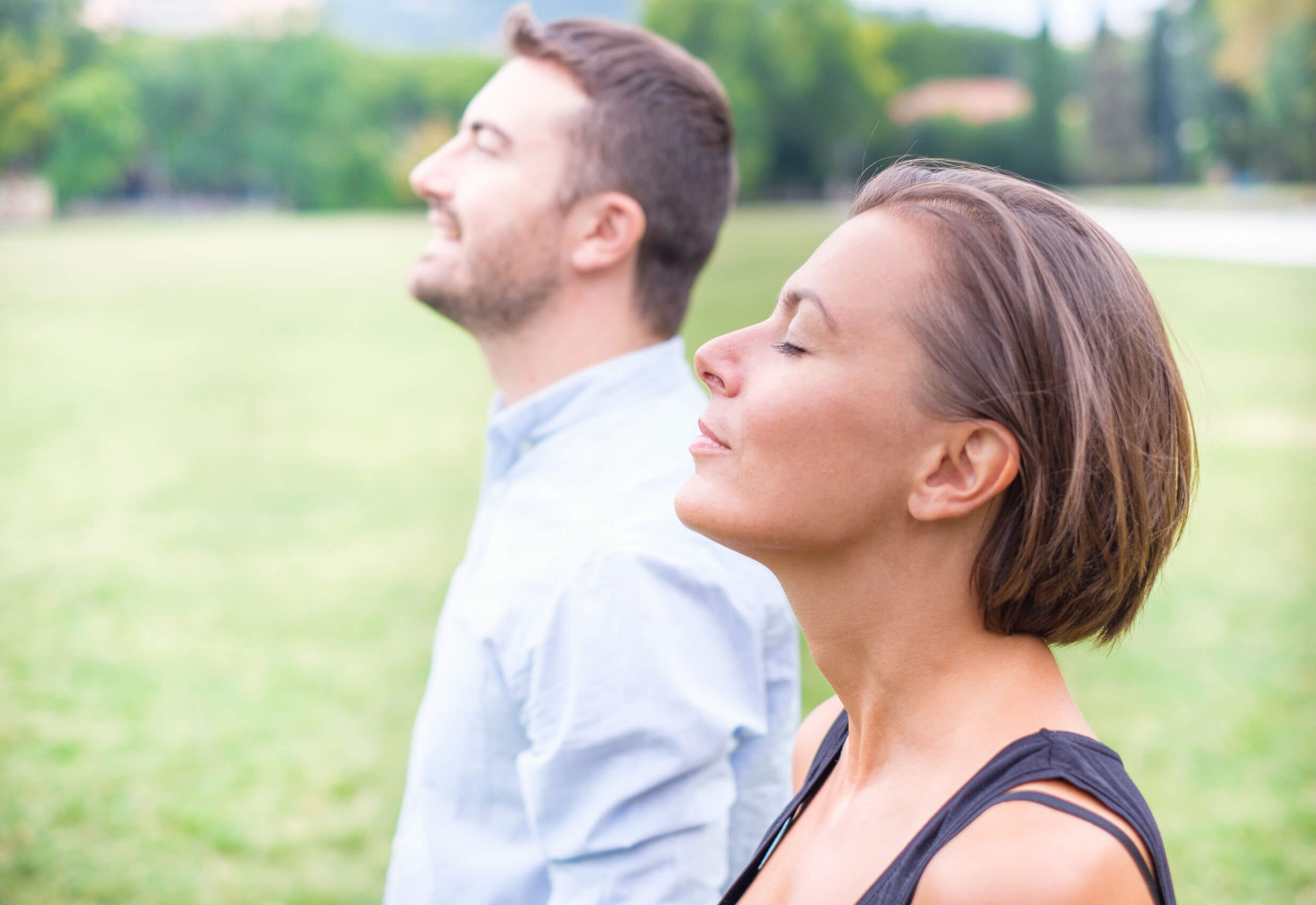5 Breathing Techniques to Sleep Better

Breathing techniques to sleep better should become a major part of our routine. Over time they’ll become a relaxation technique against anxiety and stress. In fact, insomnia can cause various ailments, including anxiety and fear.
Breathing is divided into two basic phases: inhalation and exhalation. In the first phase, the air enters the lungs, and in the second it exits the lungs, allowing the gas to be expelled. During this process, the respiratory muscles contract and relax, allowing these two phases to be carried out successfully.
When we use one of the following breathing techniques to sleep, we are reducing much of the anxiety accumulated during the day by avoiding bringing it to bed with us. In addition to releasing carbon dioxide, we also release stress. This, in turn, can ensure that we won’t wake up in the middle of the night due to apnea.
The process of breathing

When we breathe, we introduce oxygen from the air into the blood and eliminate the carbon dioxide that has accumulated in the tissues. This process, which takes the name of “gas exchange”, takes place inside the lungs, in the alveoli. These structures are found in the most distal part of the bronchioles.
When the body is at rest, the organs are also better oxygenated, as the blood carries more oxygen. If the airways are permeable, that is, without obstructions, more oxygen will enter; as a result, we’ll breathe better and won’t wake up in the middle of the night.
Why will breathing help us sleep better?
Breathing helps us sleep better! It’s true! When we go to sleep, our state of consciousness loosens, we relax our body, and the brain’s electrical activity changes, giving rise to two sleep phases: REM and NREM. At each stage, breathing is essential.
When we prepare to sleep and our breathing is correct, the body relaxes and the heart rate slows down to promote sleep. Additionally, hormones such as melatonin are released.
If our breathing isn’t correct, one of the most common consequences is obstructive sleep apnea (OSAS). This disorder hinders our breathing while we sleep because tissues close and block the airways. Snoring can be a symptom of obstructive sleep apnea!
Sleep better, the importance of our surroundings
Breathing techniques to sleep better are most effective if the bedroom has ideal conditions. Both factors contribute to the same goal: to sleep well. The importance of properly organizing the environment we sleep in, in order to facilitate rest, is confirmed by research.
The first factor to consider when adapting the bedroom is ventilation. An ideal temperature will help us to sleep much better. Added to this is the need to have a good mattress and comfortable pillows that give us a good posture.
It’s also important to be able to rest in a place without noise, lights, or other factors that can cause a disturbance.
This helps us sleep deeply and helps us not to get into a light sleep where anything can wake us up.
5 breathing techniques to sleep better
By applying the following breathing techniques, we can fall asleep much faster. As a result, we’ll have a more restful sleep.
1. Use the diaphragm
To use your diaphragm fully, sit with your heels flat and straighten your back. Once you have reached this position, bring your arms back and place your hands on your heels. Take a deep breath, directing the air to the bottom of the lungs. It’s important that you bring your chest forward as you exhale.
2. Stretch

Research has shown that, thanks to stretching, the tension and stress accumulated during the day are released. With your hands joined, stand on your toes and raise your arms. As you perform this movement, breathe slowly. As you exhale, release the air very slowly. Take your time.
3. 20-minute technique
Start by going to bed at the same time every day. If, after 20 minutes, you can’t get to sleep, get up and do some non-stimulating activity, such as walking or sitting. Avoid standing in front of a screen, cell phones, or a television. Research has shown that this reduces the desire to sleep and can cause severe sleep disturbances.
As soon as the urge to sleep returns, go back to bed and try again. Do this as often as you feel necessary.
4. A relaxation and breathing technique
This relaxation and breathing technique increases the CO2 in the blood during sleep. Thanks to its sedative effect, it’s possible to rest more during the night. Follow these steps:
- Lie on your back with your head at the same height as your body.
- Close your eyes and inhale without forcing the lungs.
- Breathe out, gently letting out all the air.
- Repeat this process three times.
- On the third inhalation, hold the air as long as possible.
After repeating these steps, five to eight times, your breathing will be more relaxed and calm, so you’ll get to sleep more easily. This method is also known as intermittent hypoxia – it must always be carried out in a controlled manner to avoid negative effects.
5. Technique 4-7-8
Andrew Weil, a US physician and author, developed the 4-7-8 technique for better sleep. It consists of closing your mouth and inhaling for a count of four, holding your breath for seven seconds, and exhaling the air from the lungs for 8 seconds. When blowing out the air, a loud sound must be emitted.
This technique shouldn’t be performed more than four times a day.
Have you tried these breathing techniques to sleep better?
Breathing techniques help us only if performed consistently. As in any practice, it’s difficult for them to work right away. You need to have a little patience.
When combined with good sleep hygiene, such as sleeping in a dark, noiseless environment or adopting good posture, they’ll help you have a restful sleep.
We have told you about five, and over time you’ll be able to identify which ones work best for you. Remember, we aren’t all the same!
Breathing techniques to sleep better should become a major part of our routine. Over time they’ll become a relaxation technique against anxiety and stress. In fact, insomnia can cause various ailments, including anxiety and fear.
Breathing is divided into two basic phases: inhalation and exhalation. In the first phase, the air enters the lungs, and in the second it exits the lungs, allowing the gas to be expelled. During this process, the respiratory muscles contract and relax, allowing these two phases to be carried out successfully.
When we use one of the following breathing techniques to sleep, we are reducing much of the anxiety accumulated during the day by avoiding bringing it to bed with us. In addition to releasing carbon dioxide, we also release stress. This, in turn, can ensure that we won’t wake up in the middle of the night due to apnea.
The process of breathing

When we breathe, we introduce oxygen from the air into the blood and eliminate the carbon dioxide that has accumulated in the tissues. This process, which takes the name of “gas exchange”, takes place inside the lungs, in the alveoli. These structures are found in the most distal part of the bronchioles.
When the body is at rest, the organs are also better oxygenated, as the blood carries more oxygen. If the airways are permeable, that is, without obstructions, more oxygen will enter; as a result, we’ll breathe better and won’t wake up in the middle of the night.
Why will breathing help us sleep better?
Breathing helps us sleep better! It’s true! When we go to sleep, our state of consciousness loosens, we relax our body, and the brain’s electrical activity changes, giving rise to two sleep phases: REM and NREM. At each stage, breathing is essential.
When we prepare to sleep and our breathing is correct, the body relaxes and the heart rate slows down to promote sleep. Additionally, hormones such as melatonin are released.
If our breathing isn’t correct, one of the most common consequences is obstructive sleep apnea (OSAS). This disorder hinders our breathing while we sleep because tissues close and block the airways. Snoring can be a symptom of obstructive sleep apnea!
Sleep better, the importance of our surroundings
Breathing techniques to sleep better are most effective if the bedroom has ideal conditions. Both factors contribute to the same goal: to sleep well. The importance of properly organizing the environment we sleep in, in order to facilitate rest, is confirmed by research.
The first factor to consider when adapting the bedroom is ventilation. An ideal temperature will help us to sleep much better. Added to this is the need to have a good mattress and comfortable pillows that give us a good posture.
It’s also important to be able to rest in a place without noise, lights, or other factors that can cause a disturbance.
This helps us sleep deeply and helps us not to get into a light sleep where anything can wake us up.
5 breathing techniques to sleep better
By applying the following breathing techniques, we can fall asleep much faster. As a result, we’ll have a more restful sleep.
1. Use the diaphragm
To use your diaphragm fully, sit with your heels flat and straighten your back. Once you have reached this position, bring your arms back and place your hands on your heels. Take a deep breath, directing the air to the bottom of the lungs. It’s important that you bring your chest forward as you exhale.
2. Stretch

Research has shown that, thanks to stretching, the tension and stress accumulated during the day are released. With your hands joined, stand on your toes and raise your arms. As you perform this movement, breathe slowly. As you exhale, release the air very slowly. Take your time.
3. 20-minute technique
Start by going to bed at the same time every day. If, after 20 minutes, you can’t get to sleep, get up and do some non-stimulating activity, such as walking or sitting. Avoid standing in front of a screen, cell phones, or a television. Research has shown that this reduces the desire to sleep and can cause severe sleep disturbances.
As soon as the urge to sleep returns, go back to bed and try again. Do this as often as you feel necessary.
4. A relaxation and breathing technique
This relaxation and breathing technique increases the CO2 in the blood during sleep. Thanks to its sedative effect, it’s possible to rest more during the night. Follow these steps:
- Lie on your back with your head at the same height as your body.
- Close your eyes and inhale without forcing the lungs.
- Breathe out, gently letting out all the air.
- Repeat this process three times.
- On the third inhalation, hold the air as long as possible.
After repeating these steps, five to eight times, your breathing will be more relaxed and calm, so you’ll get to sleep more easily. This method is also known as intermittent hypoxia – it must always be carried out in a controlled manner to avoid negative effects.
5. Technique 4-7-8
Andrew Weil, a US physician and author, developed the 4-7-8 technique for better sleep. It consists of closing your mouth and inhaling for a count of four, holding your breath for seven seconds, and exhaling the air from the lungs for 8 seconds. When blowing out the air, a loud sound must be emitted.
This technique shouldn’t be performed more than four times a day.
Have you tried these breathing techniques to sleep better?
Breathing techniques help us only if performed consistently. As in any practice, it’s difficult for them to work right away. You need to have a little patience.
When combined with good sleep hygiene, such as sleeping in a dark, noiseless environment or adopting good posture, they’ll help you have a restful sleep.
We have told you about five, and over time you’ll be able to identify which ones work best for you. Remember, we aren’t all the same!
- Garay, V. S. Recomendaciones para mejorar su sueño durante la cuarentena por pandemia COVID 19.
- Estudiantil, V. (2020). Guía de autoayuda-¿ Cómo enfrentar el insomnio?
- Baides Noriega, Raquel, Noriega Camporro, Sara, & Inclán Rodríguez, Alicia María. (2019). Enfermería y Tratamiento no Farmacológico para el Manejo del Insomnio. Enfermería Global, 18(54), 512-532. Epub 14 de octubre de 2019.
- Karpenko, V. (2019). Trastorno de ansiedad en niños. Tus psicólogos en CDMX: Irradia Terapia.
- Llobell, M. A. (2020). Técnicas para relajarse.
- Karpenko, V. (2019). Trastorno de ansiedad en niños. Tus psicólogos en CDMX: Irradia Terapia.
- Rodríguez, T. R., Rodríguez, C. M. G., & Pérez, R. C. (2005). Técnicas de relajación y autocontrol emocional. MediSur, 3(3), 55-70.
- García Cabrera, Lizet, Rodríguez Reyes, Oscar, & Rodríguez Carballosa, Oscar Bernardo. (2011).
- Regulación de la respiración: organización morfofuncional de su sistema de control. MEDISAN, 15(4), 558-567. Recuperado en 08 de marzo de 2021, de http://scielo.sld.cu/scielo.php?script=sci_arttext&pid=S1029-30192011000400020&lng=es&tlng=es.
- Velayos, J. L., Moleres, F. J., Irujo, A. M., Yllanes, D., & Paternain, B.. (2007). Bases anatómicas del sueño. Anales del Sistema Sanitario de Navarra, 30(Supl. 1), 7-17. Recuperado en 09 de marzo de 2021, de http://scielo.isciii.es/scielo.php?script=sci_arttext&pid=S1137-66272007000200002&lng=es&tlng=es.
- Morales-Blanhir, Jaime Eduardo, Valencia-Flores, Matilde, & Lozano-Cruz, Oscar Arturo. (2017). El síndrome de apnea obstructiva del sueño como factor de riesgo para enfermedades cardiovasculares y su asociación con hipertensión pulmonar. Neumología y cirugía de tórax, 76(1), 51-60. Recuperado en 08 de marzo de 2021, de http://www.scielo.org.mx/scielo.php?script=sci_arttext&pid=S0028-37462017000100051&lng=es&tlng=es.
- Olivares, R.J. y Méndez C.F (2001). Técnicas de modificación de conducta (Tercera edición). Biblioteca Nueva.
- Bados, A., & García-Grau, E. (2011). Técnicas operantes. Recuperado de http://diposit. ub. edu/dspace/bitstream/2445/18402/1/Técnicas% 20operantes, 202011.
- Weil, A. (2017). Three breathing exercises. DrWeil. com. Retrieved from.
- Patiño, J. F., Restrepo, J. F. P., & Rodríguez, E. C. (2005). Gases sanguíneos, fisiología de la respiración e insuficiencia respiratoria aguda. Ed. Médica Panamericana.
- García López, Sergio J., & Navarro Bravo, Beatriz. (2017). Higiene del sueño en estudiantes universitarios: conocimientos y hábitos. Revisión de la bibliografía. Revista Clínica de Medicina de Familia, 10(3), 170-178. Recuperado en 11 de marzo de 2021, de http://scielo.isciii.es/scielo.php?script=sci_arttext&pid=S1699-695X2017000300170&lng=es&tlng=es.
Este texto se ofrece únicamente con propósitos informativos y no reemplaza la consulta con un profesional. Ante dudas, consulta a tu especialista.







